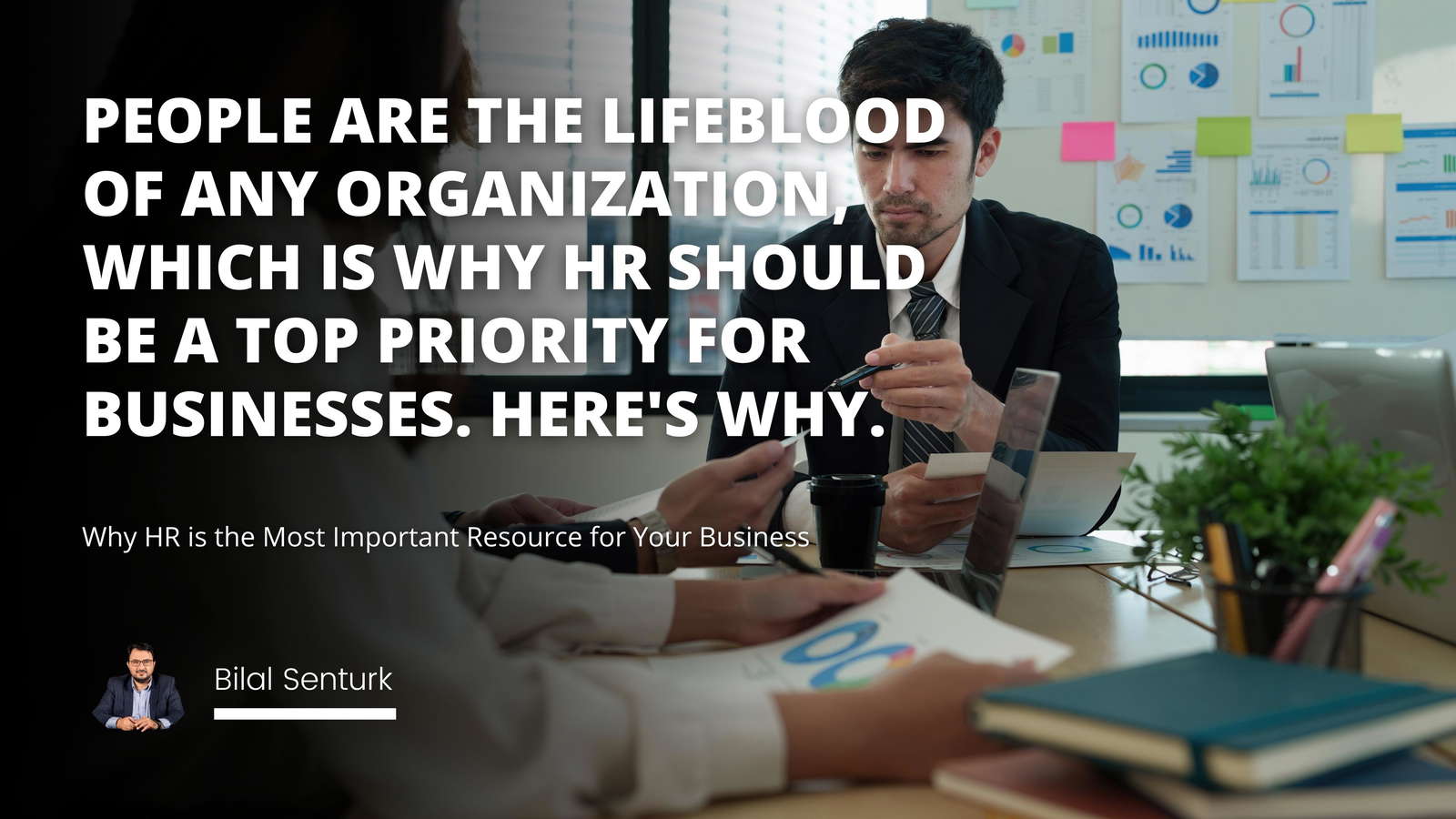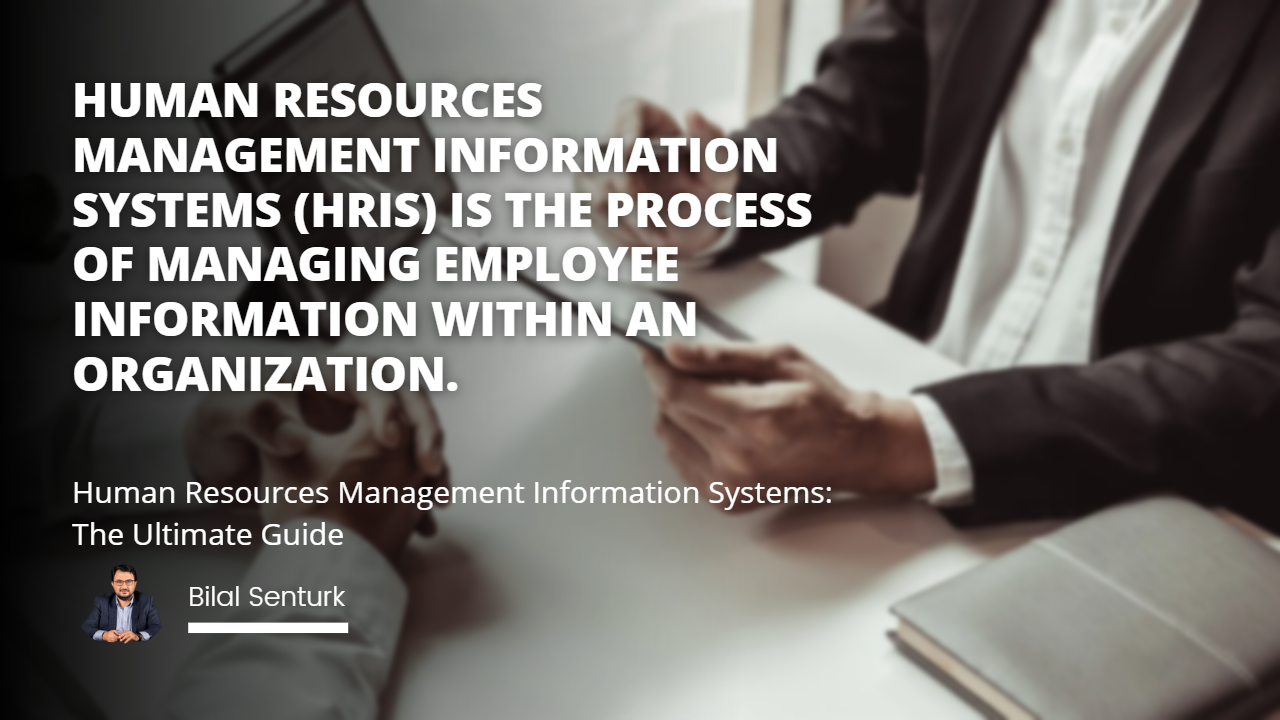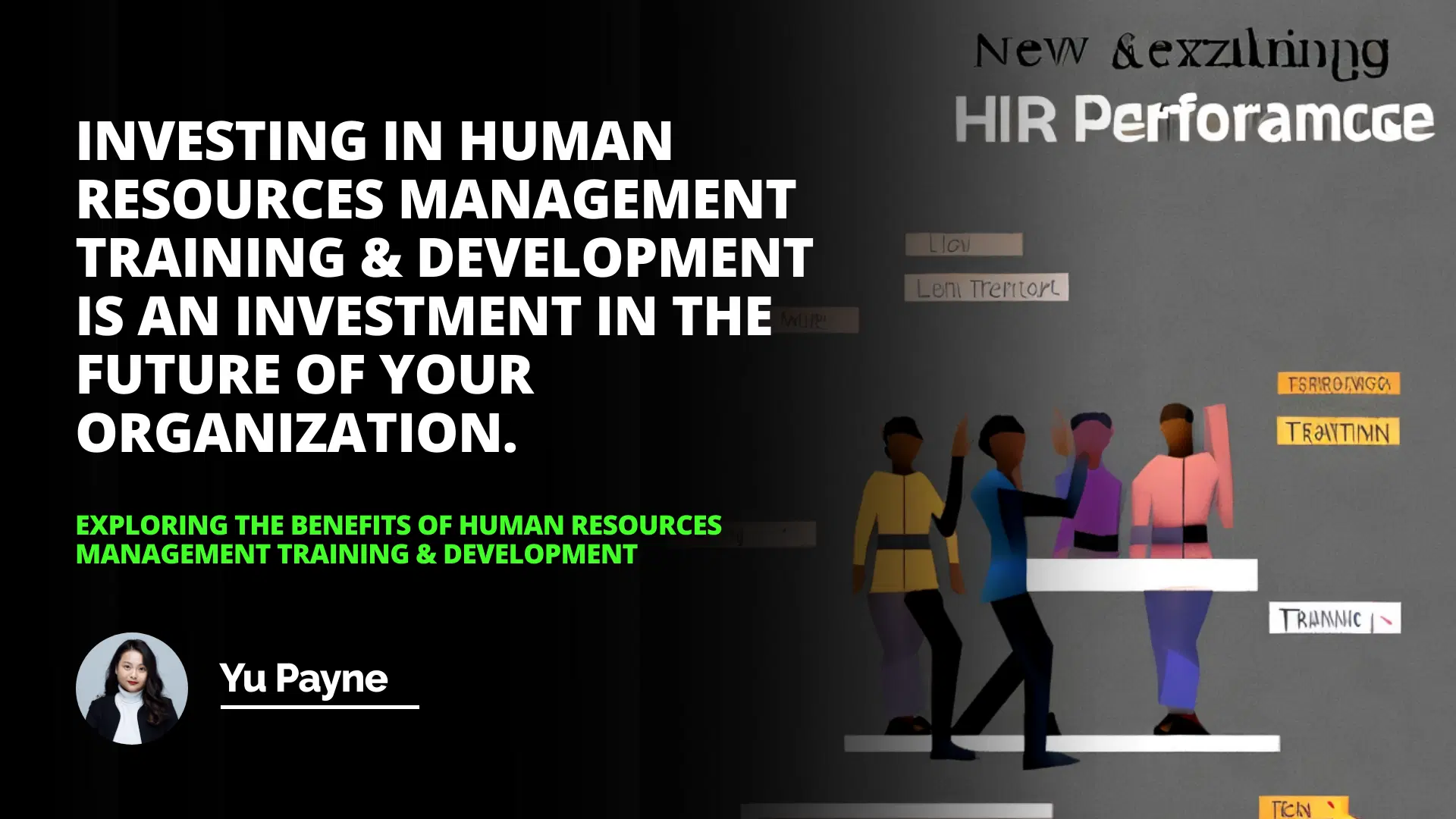
This article explores the benefits of Human Resources Management Training & Development, discussing the specific training and development processes and career development. Training and development are essential for any organization as it helps to ensure that employees have the skills and knowledge they need to perform their job successfully. In contrast, career development helps employees identify their career goals and develop strategies to reach them. Managers play an essential role in training and development, as they are responsible for determining when training is needed and the best approach to take, as well as providing mentoring and guidance to employees.
Introduction
Exploring the Benefits of Human Resources Management Training & Development
Training and Development
Career Development
Conclusion
Introduction: Human Resources Management Training & Development is essential to any organization. It is vital to have a well-trained and developed workforce to ensure the organization's success. Training and development are critical elements of HR management, and it is the responsibility of managers to determine when training is needed and the best approach to take.
This article will explore the benefits of HR management training and development and discuss the various aspects of training and development, including career development.
Exploring the Benefits of Human Resources Management Training & Development
Training and development are essential for any organization as it helps to ensure that the employees have the skills and knowledge they need to perform their job successfully. Training and development also help to ensure that employees are up-to-date on new skills and technologies. Training and development can also help reduce turnover rates and increase job satisfaction.
HR management training and development can also help to improve communication between employees and management, which can help to create a better working environment.
Training and Development
Training and development are two distinct but related processes. Training teaches employees new skills and knowledge to help them perform their job more effectively. Development, on the other hand, is assisting employees in developing their existing skills and expertise to help them reach their full potential. Training and development are essential for any organization as it helps to ensure that employees have the skills and knowledge they need to succeed.
HR Service Delivery: Optimizing Workforce Value in Modern Businesses
HR Risk Management: Strategies for Optimal Employee Performance
Career Development
Career development is an integral part of training and development. It involves helping employees identify their career goals and developing strategies to reach them. This includes analyzing current skills and succession planning. Career development involves mentoring, which is where managers may come in. Mentoring helps to provide employees with the guidance and support they need to reach their goals.
Conclusion: Human Resources Management Training & Development is essential for any organization. It helps to ensure that employees have the skills and knowledge they need to perform their job and reach their full potential.
Training and development are two distinct but related processes, and career development is an essential part of training and development. Managers play an important role in training and development, determining when training is needed and the best approach. Additionally, they may be involved in mentoring employees and helping them to reach their career goals.
Investing in Human Resources Management Training & Development is an investment in your organization's future.
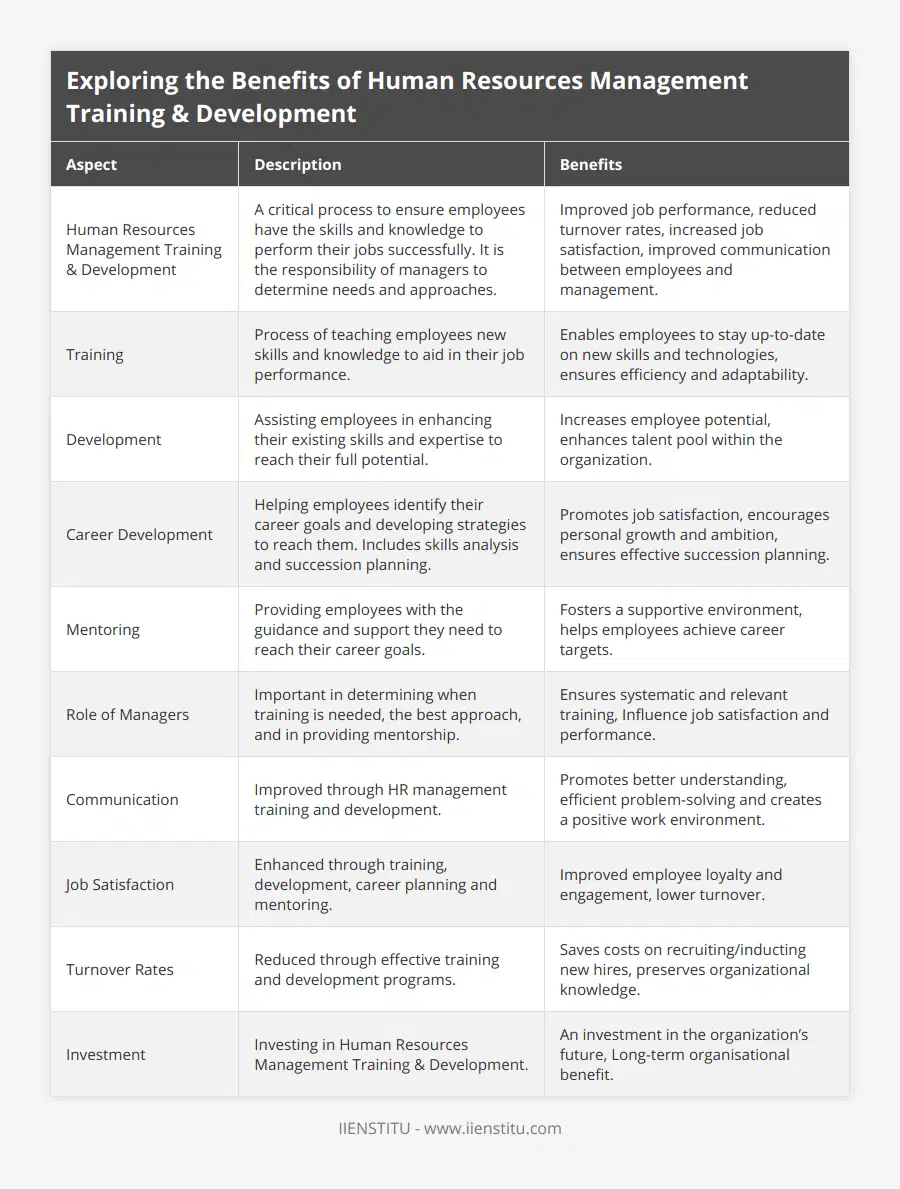
Frequently Asked Questions
What are the primary benefits of Human Resources Management Training & Development?
Implementing Human Resources Management Training & Development (HRMT&D) offers several primary benefits for organizations. These benefits can be categorized as those related to employees, to the organization as a whole, and the development of an ethical organizational culture.
From the employees' perspective, HRMT&D provides personal and professional growth opportunities. Through training and development, employees can acquire new skills and knowledge and improve existing skills. This development can lead to increased job satisfaction and motivation, ultimately leading to higher performance. Furthermore, HRMT&D can allow employees to gain recognition for their accomplishments, further encouraging them to strive for excellence.
From the organization's perspective, HRMT&D can help foster a culture of continuous learning and improvement. By investing in employees’ development, organizations can ensure that they are equipped with the necessary skills to meet new challenges and remain competitive. In addition, HRMT&D can help organizations reduce employee turnover, as employees can advance their careers within the organization rather than seek job opportunities elsewhere. Additionally, by providing employees with training, organizations can ensure that they are meeting regulatory requirements and providing a safe and healthy work environment.
Finally, HRMT&D can help organizations to develop and maintain an ethical organizational culture. By providing training and development, organizations can ensure that employees are familiar with organizational policies and procedures and are aware of ethical behavior's importance. This helps to ensure that employees can make informed decisions and act in a manner that is consistent with the organization’s values.
In conclusion, HRMT&D is an essential component of any successful organization. It provides several primary benefits for organizations, their employees, and the development of an ethical organizational culture. By investing in HRMT&D, organizations can ensure that they can remain competitive while also providing employees with the opportunity to grow and develop.

How can Human Resources Management Training & Development help to improve employee performance?
Human Resources Management Training & Development (HRMT&D), which includes providing resources, materials, and guidance to employees, is integral to any organization's successful growth and development. As an important part of an organization's overall management strategy, HRMT&D can play an essential role in improving the performance of the organization's employees.
Organizations must adapt quickly to changing market conditions and customer demands in today's competitive and globalized business environment. This requires the organization to have a workforce with the necessary skills, knowledge, and abilities to meet these demands. HRMT&D can help organizations achieve this by providing employees with the necessary training and development to improve their performance.
The importance of HRMT&D in improving employee performance is linked to the essential role of HRMT&D in providing employees with the necessary resources, materials, and guidance to perform their job. By providing employees with the necessary resources, materials, and guidance, organizations can ensure that employees have the essential skills, knowledge, and abilities required to perform their job successfully. This can help to increase employee productivity and performance, as well as reduce employee turnover.
In addition to providing employees with the necessary resources, materials, and guidance, HRMT&D can also help to ensure that employees are motivated to work productively and efficiently. By providing employees with the appropriate rewards and recognition for their efforts, organizations can ensure that employees are motivated to work productively and efficiently. This can lead to increased performance and improved morale and job satisfaction.
Finally, HRMT&D can help organizations to foster a culture of innovation and creativity. By providing employees with the necessary resources, materials, and guidance, organizations can ensure that employees can think creatively and come up with innovative solutions to problems. This can lead to improved performance and increased employee morale and job satisfaction.
In conclusion, HRMT&D can play an essential role in improving employee performance. By providing employees with the necessary resources, materials, and guidance, as well as appropriate rewards and recognition, HRMT&D can help organizations to foster a culture of innovation and creativity. This can lead to improved performance and increased employee morale and job satisfaction.
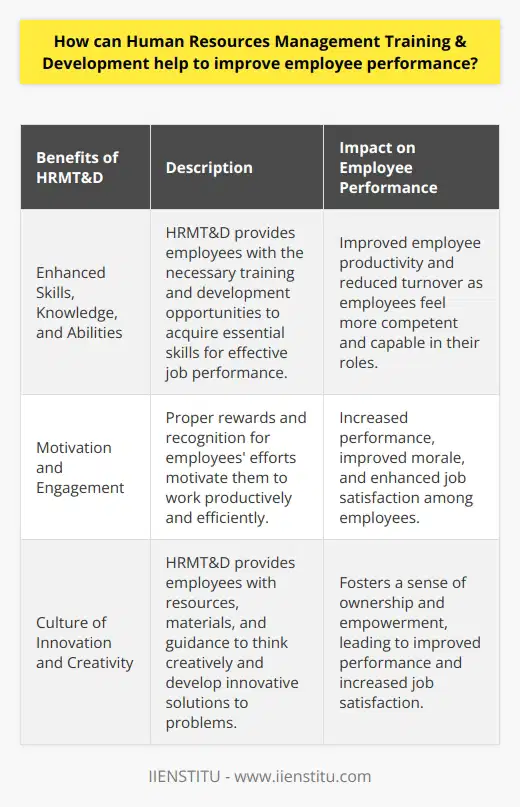
What strategies can be used to ensure successful implementation of Human Resources Management Training & Development?
Human Resources Management Training & Development (HRMT&D) is critical for the success of any organization. When properly implemented, HRMT&D can increase employee morale, strengthen relationships between departments and employees, and facilitate better communication between management and employees. However, the successful implementation of HRMT&D can be a challenging process. To ensure the successful implementation of HRMT&D, there are several strategies that organizations can use.
First, organizations should create a comprehensive HRMT&D plan tailored to their specific needs and objectives. This plan should include goals, objectives, and strategies for achieving them. It should also include a timeline and budget to ensure that the goals are met promptly and cost-effectively. Additionally, organizations should ensure that the plan is regularly reviewed and updated to remain relevant and practical.
Second, organizations should identify and select the appropriate HRMT&D tools and approaches. This includes selecting the appropriate software and training materials and selecting the right people to lead and facilitate the training and development process. This can be done through internal and external resources, such as hiring external consultants or working with industry experts.
Third, organizations should establish a culture of learning within the organization. This includes encouraging employees to seek out additional training opportunities, participate in professional development activities, and take advantage of available resources. This can help create an environment where employees constantly learn and develop their skills.
Finally, organizations should measure the effectiveness of their HRMT&D plan. This can be done through various methods, such as surveys and performance reviews. Measuring the plan's effectiveness can help identify areas where the plan can be improved and ensure that the organization is getting the desired results from its HRMT&D efforts.
These are just a few strategies that organizations can use to ensure the successful implementation of Human Resources Management Training & Development. By following these strategies, organizations can ensure that their HRMT&D efforts are successful and provide the desired results.
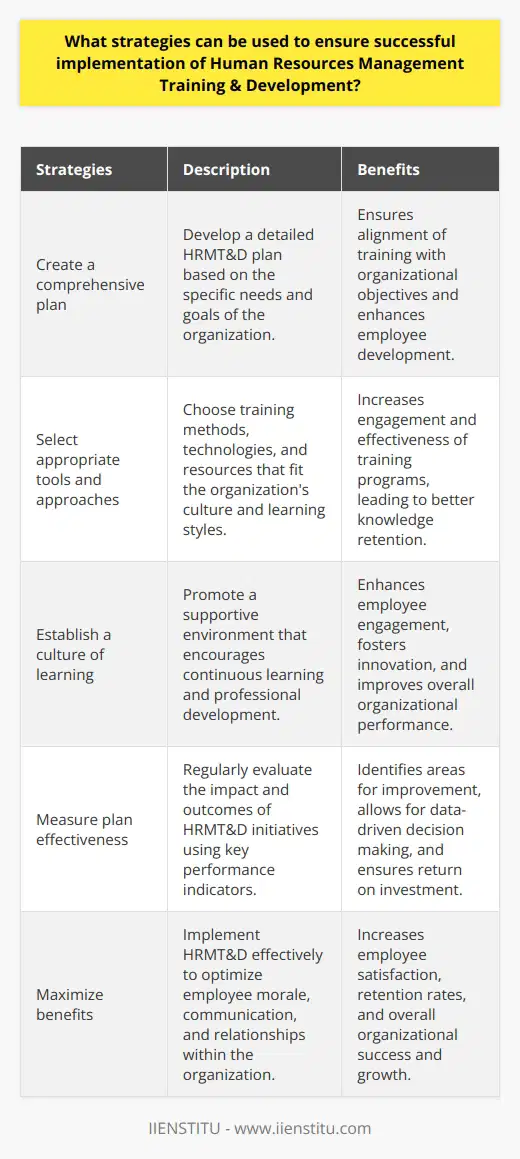
Why is training and development important to human resource management?
Role of Training and Development
Training and development play a critical role in human resource management, primarily because it enhances the skills, knowledge, and abilities of employees. By investing in their workforce, organizations can effectively bridge the gap between the required skills for optimal job performance and the existing competencies of employees.
Workforce Improvement and Efficiency
One of the main benefits of training and development is the continuous improvement of the workforce. Through well-structured learning programs, employees can develop the necessary skillset to perform their tasks efficiently. This, in turn, leads to increased productivity and overall organizational growth.
Employee Adaption and Career Advancement
Professional development opportunities make it easier for employees to adapt to changes in their roles and responsibilities, as they are often required to acquire new skills to remain relevant in the ever-evolving job market. Furthermore, training and development programs can serve as a catalyst for employee progression in careers, as these initiatives facilitate the acquisition of the necessary tools for upward mobility.
Employee Retention and Job Satisfaction
Another crucial aspect of training and development in human resource management is its impact on employee retention and job satisfaction. Employees who feel valued and equipped with the necessary resources to perform their job efficiently are more likely to exhibit better performance results and retain their positions within the company. The positive relationship between employee satisfaction and effective training fosters a sense of loyalty and commitment, ultimately reducing the turnover rate.
Organizational Reputation and Attraction
Moreover, training and development initiatives contribute significantly to an organization's reputation. Companies known for investing in their employees' growth and development are more likely to attract top talent seeking long-term career growth. A strong commitment to employee advancement gives organizations a competitive edge, as proficiently trained individuals contribute substantially to the overall success of the company.
Conclusion
In conclusion, training and development are essential elements of human resource management, as they significantly impact an organization's ability to attract, retain, and develop a skilled workforce. By investing in employee growth, companies can ensure a high level of productivity, efficiency, and satisfaction, ultimately resulting in a sustainable competitive advantage.
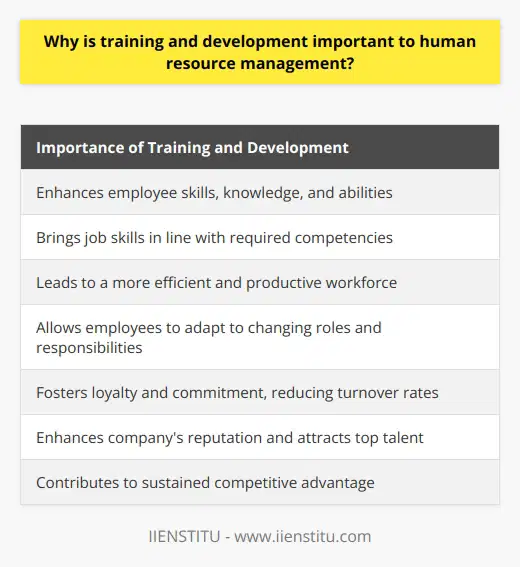
What are the benefits of human resource management?
Role of Strategic Approach
Human resource management (HRM) plays a crucial role in the success of any organization by strategically aligning people's capabilities with the organization's objectives. It ensures a productive and motivated workforce through effective talent acquisition, performance management, and career development plans. Consequently, the organization benefits from heightened levels of employee satisfaction and retention, leading to increased overall performance.
Impact on Organizational Performance
HRM contributes to improving an organization's performance by efficiently managing employee performance, creating a cohesive workplace culture, and facilitating clear communication channels. By establishing clearly defined roles and responsibilitie, employees are better equipped to contribute to the organization's goals, ultimately resulting in improved performance. Moreover, HRM policies and practices facilitate employee engagement and satisfaction, subsequently improving motivation and productivity.
Promoting Employee Development
Investing in employee development is an indispensable component of HRM. Providing relevant training and skill development opportunities for employees contributes to personal growth and improved performance. When employees possess the necessary skills and knowledge to excel in their roles, they are more likely to remain motivated and loyal to the organization, directly supporting its long-term success.
Managing Change and Adaptation
In today's ever-changing business environment, organizations must adapt to remain competitive. HRM plays a vital role in managing change by implementing strategies that foster a smooth transition and an agile work environment. These measures ensure that employees and the organization as a whole adapt effectively to evolutions in the marketplace, enabling businesses to maintain their competitiveness through innovation and continuous improvement.
Enhancing Employee Well-being
HRM places significant emphasis on employee well-being, implementing policies and programs that promote a healthy work-life balance. Such initiatives include flexible work arrangements, employee assistance programs, and comprehensive benefits packages. These efforts contribute to the overall well-being of the workforce, ensuring employees remain engaged, motivated, and productive.
Safeguarding Legal Compliance
A critical aspect of HRM is ensuring adherence to employment laws and regulations. Maintaining a compliant work environment protects organizations from potential legal disputes or financial penalties, safeguarding the company's reputation and financial stability. Additionally, HRM plays a pivotal role in advocating for and promoting fair and equitable treatment for all employees, further enhancing employee satisfaction and contributing to a positive workplace culture.
In conclusion, human resource management serves as an integral component of an organization's success, providing numerous benefits ranging from enhanced performance to effective change management. By adopting comprehensive HRM strategies and policies, organizations can cultivate an engaged, motivated, and agile workforce poised to support their long-term growth and competitiveness.
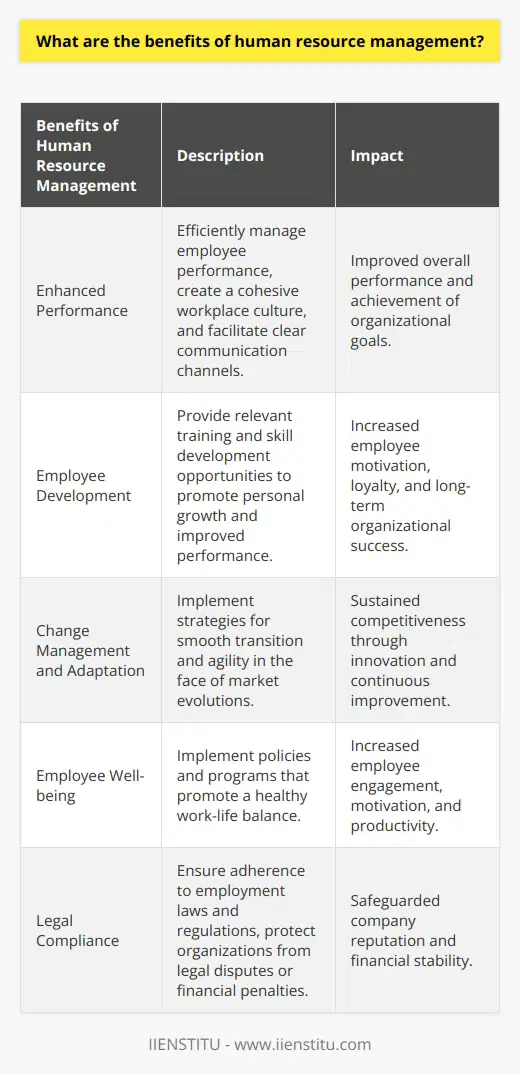
How can effective human resource management contribute to organizational success?
Effect of Effective HR Management on Organizational Success
Effective human resource management plays a pivotal role in an organization's success as it influences various aspects of the workplace. By focusing on employee satisfaction, HR management can ensure that employees remain motivated and engaged in their work. This, in turn, leads to increased productivity and better overall organizational performance.
Recruitment and Selection of Talent
An essential task of HR management is identifying and recruiting the best talent to meet an organization's needs. By hiring individuals who possess the right skills and knowledge, HR management sets the foundation for a successful workforce. Furthermore, HR management ensures a seamless onboarding experience, which helps new employees feel welcome and become acclimated to the organization swiftly.
Training and Development Opportunities
HR management must ensure employees receive necessary training and development opportunities to excel in their roles. This includes providing employees with access to continuous learning and skill development programs. These opportunities enhance overall productivity and enable employees to expand their knowledge base and stay up-to-date with industry trends.
Performance Management and Feedback
Effective HR management also involves implementing well-defined performance management systems that evaluate individual and team performance regularly. By providing employees with constructive feedback, HR management encourages continuous improvement and fosters a culture of high performance. This leads to increased employee satisfaction and retention, providing the organization with a stable, skilled workforce.
Employee Engagement and Satisfaction
Proactive HR management focuses on employee engagement and satisfaction, using various strategies such as recognition programs, flexible work arrangements, and employee wellness initiatives to improve morale. By creating a positive work environment and offering support to employees, HR management contributes significantly to increased productivity and overall organizational success.
Maintaining Compliance and Mitigating Risks
Finally, effective HR management plays a crucial role in ensuring compliance with labor laws and regulations. By maintaining proper documentation and addressing employee issues promptly, HR management mitigates potential risks and legal issues that may arise in the workplace. Organizations that adhere to HR practices and ensure compliance are more likely to succeed, as it reduces disruptions to their operations.
In conclusion, effective human resource management is a vital component of an organization's success. By addressing the needs of employees and ensuring a robust talent pipeline, HR management directly impacts organizational performance and productivity. Thus, businesses must prioritize HR management strategies to drive long-term success and growth.
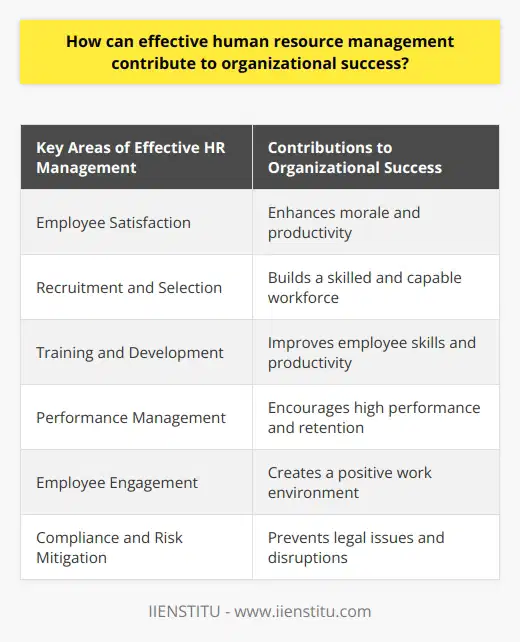
What are the essential components of effective human resource development programs?
Essential Components of Effective HRD Programs
Targeted Skills and Knowledge
An effective Human Resource Development (HRD) program is crucial for organizational success. One essential component of such programs is to target specific skills and knowledge areas that are relevant to the organization's needs. This involves aligning the training content with the company's strategic goals and the individual employee's development plan.
Competent Trainers
Another essential component of an effective HRD program is employing competent trainers. These experts should have adequate experience, qualifications, and industry-specific knowledge that will enable them to communicate the necessary information effectively. Competent trainers help ensure that employees who participate in the training programs obtain relevant and applicable knowledge.
Collaborative Learning Approaches
Incorporating collaborative learning approaches is another essential aspect of HRD programs. These approaches, which include group discussions, case studies, and team-based projects, foster an atmosphere of open communication and collective problem-solving. Collaborative learning enhances participant engagement and helps them retain new information more effectively, leading to more successful outcomes.
Continuous Feedback and Assessment
To measure the effectiveness of HRD programs, continuous feedback and assessment are necessary. This involves providing feedback on participants' performance, gauging their progress, and assessing the overall success of the training program. Gathering feedback allows program managers to tailor future training sessions and continuously improve the HRD initiative.
Culture of Continuous Learning
Lastly, cultivating a culture of continuous learning is essential for the long-term success of HRD programs. This environment encourages employees to seek out further opportunities for skill development, even after the formal training has ended. By fostering a culture of continuous learning, organizations benefit from a more skilled, adaptable, and motivated workforce.
In conclusion, effective HRD programs consist of several essential components, including targeted skills and knowledge, competent trainers, collaborative learning approaches, continuous feedback and assessment, and a culture of continuous learning. Together, these elements contribute to the success of HRD initiatives, enabling organizations to cultivate a skilled and capable workforce capable of achieving their strategic goals.
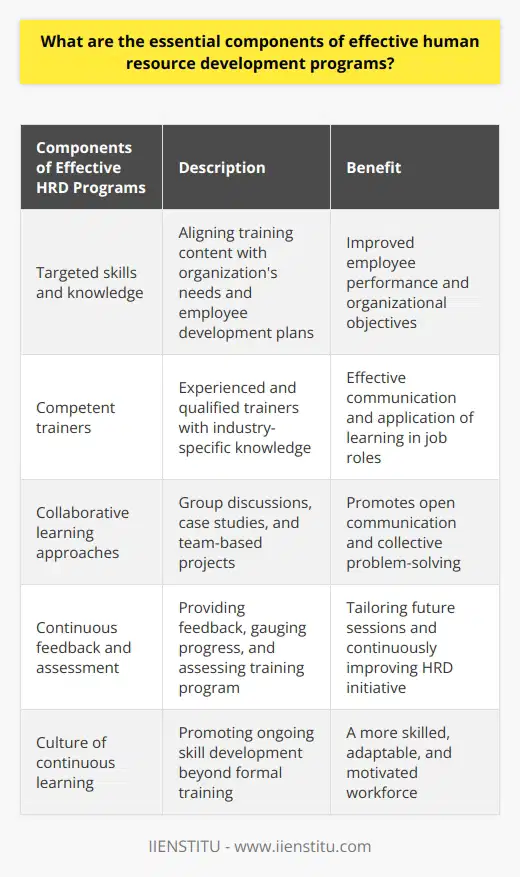
How does investing in human resource management training contribute to long-term organizational growth and sustainability?
Impact on Employee Development
Investing in human resource management training plays a crucial role in driving long-term organizational growth and sustainability. Through effective training programs, employees at all levels develop essential skills and competencies, leading to continued improvement in job performance. A well-trained workforce has a significant impact on overall productivity, fostering a competitive advantage in today's rapidly evolving business environment.
Enhanced Employee Retention
Furthermore, comprehensive and targeted training programs contribute to enhanced employee retention rates. By addressing skill gaps and providing opportunities for growth and development, organizations demonstrate their commitment to employee success. In turn, satisfied and fulfilled employees are more likely to remain loyal and committed to the company's mission and vision, reducing turnover costs and fostering a stable workforce.
Promotion of Innovation and Creativity
Training and development initiatives also promote innovation and creativity within the organization. When employees are encouraged to think critically and creatively, they are better equipped to identify opportunities for improvement and growth. This culture of continuous learning and development enables the organization to adapt to changing market demands, ensuring long-term viability and success.
Cultivation of Future Leaders
Investment in human resource management training also paves the way for cultivating the next generation of effective leaders. By identifying and developing potential leaders through mentoring and coaching programs, organizations can ensure a steady pipeline of skilled executives ready to assume critical roles. This succession planning approach not only maintains stability in leadership but also provides the organization with the ability to respond to emerging challenges and opportunities.
Improved Organizational Culture
Lastly, training and development programs lead to the creation of a healthy work environment, marked by effective communication, collaboration, and a shared commitment to organizational goals. An inclusive organizational culture attracts and retains high-potential talent, fueling growth and long-term success.
In conclusion, investing in human resource management training is essential for organizations striving for growth and sustainability. By fostering employee development, retaining valuable employees, promoting innovation and creativity, cultivating future leaders, and nurturing a vibrant organizational culture, companies committed to training and development can face the challenges of today's dynamic business environment with confidence and agility.
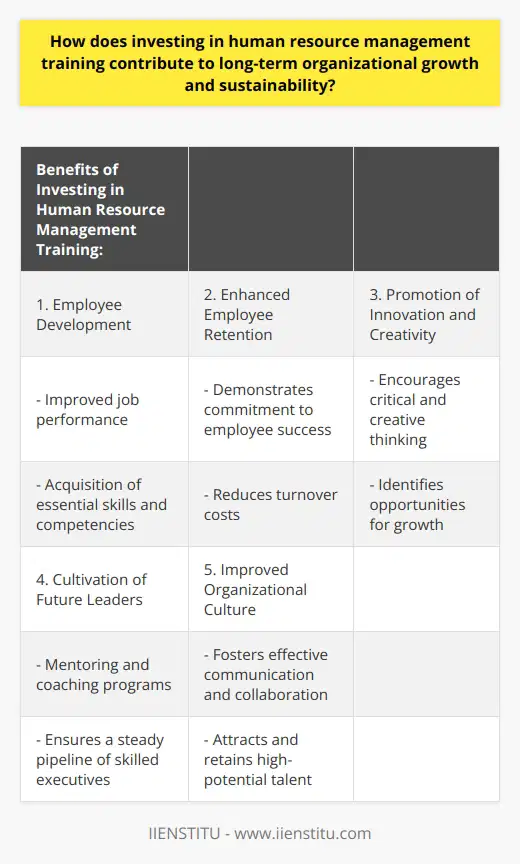
In what ways can human resource management practices enhance employee satisfaction and retention?
Effective Communication Channels
To enhance employee satisfaction and retention, human resource management (HRM) can implement practices that involve clear communication within the organization. By fostering a culture of open dialogue and transparency, HRM helps employees feel engaged, valued, and informed about company goals and initiatives.
Recognition and Rewards
HRM can also play a crucial role in recognizing and rewarding employees for their achievements and contributions. Providing regular feedback, celebrating success, and offering incentives can help in improving employee morale, job satisfaction, and loyalty.
Work-Life Balance
Promoting a healthy work-life balance is another essential HRM practice for retaining satisfied employees. This entails offering flexible work schedules, encouraging leisure-time activities, and providing stress-reduction measures to ensure employees enjoy both personal fulfillment and on-the-job productivity.
Collaborative and Supportive Work Environment
Encouraging a collaborative and supportive work environment is vital for HRM in achieving higher employee satisfaction and retention. Facilitating functional teamwork, providing ongoing professional development opportunities, and promoting a respectful company culture can reduce employee turnover and improve overall performance.
Growth and Advancement Opportunities
When organizations provide their employees with advancement opportunities, they create a loyal and motivated workforce. HRM can enhance staff productivity and ensure the retention of top talent by offering comprehensive career development programs and promoting from within the organization.
Inclusive and Diverse Workplace
An inclusive and diverse workplace fosters a sense of belonging among employees, which can significantly impact satisfaction and retention levels. HRM can contribute to creating such an environment by implementing diversity and inclusion initiatives, as well as providing equal opportunities for all staff members.
Comprehensive Compensation and Benefit Packages
Finally, ensuring competitive and comprehensive compensation and benefit packages contribute significantly to employee satisfaction and retention. HRM must continuously evaluate and update these offerings to stay in line with market standards, thereby demonstrating the organization's commitment to attracting, retaining, and rewarding high-performing employees.
In conclusion, by employing effective HRM practices, organizations can improve employee satisfaction and retention. By implementing strategies that encompass communication, recognition, work-life balance, collaboration, growth, inclusivity, and fair compensation, companies can build a strong workforce that is motivated, loyal, and highly productive.
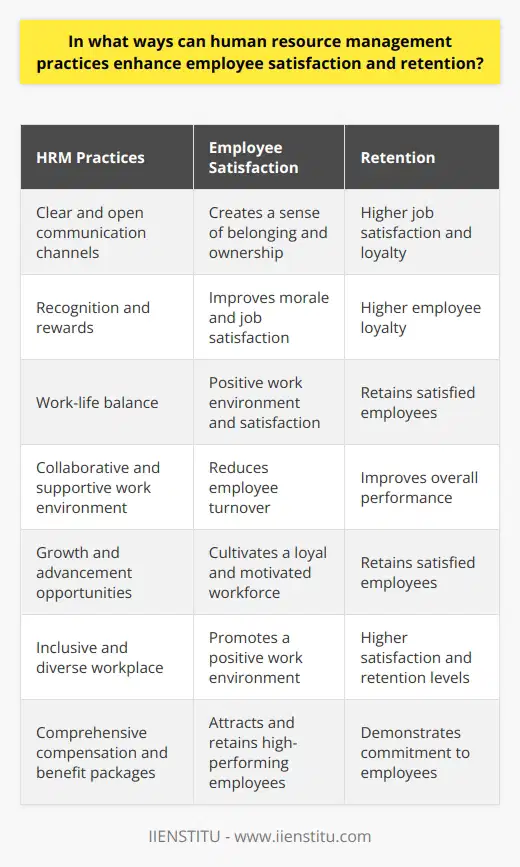
How does a comprehensive training and development program influence the overall productivity and effectiveness of an organization?
Impact on Employee Skills and Knowledge
A comprehensive training and development program significantly influences the overall productivity and effectiveness of an organization. By enhancing employees' skills and knowledge, organizations can achieve higher levels of performance and results. Continuous learning empowers employees to perform their job duties more efficiently and adapt to shifts in the market or industry. This in turn leads to better decision-making, creative problem-solving, and a greater capacity for innovation.
Increased Employee Motivation and Engagement
Training and development programs can positively impact employee motivation and engagement. When employees feel valued, supported, and challenged by their organization, they are more likely to take ownership of their responsibilities and contribute meaningfully to the organization's goals. Engaged employees demonstrate a strong commitment to their work, which leads to better job satisfaction and a higher employee retention rate. Furthermore, satisfied employees are typically more productive, efficient, and capable of delivering high-quality work.
Enhanced Quality and Compliance Standards
Organizations with comprehensive training and development programs are better equipped to maintain and improve quality and compliance standards. Proper training ensures employees understand the company's policies, procedures, and best practices, allowing them to perform their tasks with greater accuracy and precision. This reduces the likelihood of errors, mistakes, or accidents that could hurt the company's reputation or lead to financial losses. Moreover, maintaining a high level of compliance helps organizations avoid legal issues, fines, and costly penalties.
Cost Savings and Improved Efficiency
Effective training and development programs lead to cost savings by reducing the need for excessive supervision, lowering employee turnover, and minimizing operational errors. As employees become more skilled and knowledgeable, they are better able to handle their workload autonomously, thus requiring less supervision. Additionally, lower turnover rates translate into reduced recruitment and onboarding costs. With a well-trained workforce, organizations can streamline their processes and operate more efficiently, ultimately boosting overall productivity.
In conclusion, comprehensive training and development programs play a crucial role in determining an organization's productivity and effectiveness. When employees are provided with the necessary skills, knowledge, and support, they are more motivated, engaged, and capable of delivering exceptional results. Furthermore, investing in employee development enhances the company's ability to maintain quality, compliance, and efficiency, ultimately resulting in a stronger and more successful organization.
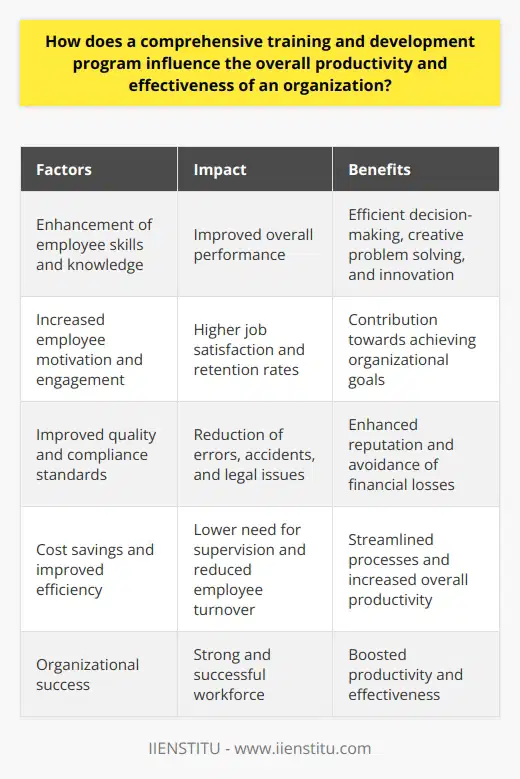
In what ways does strategic human resource management contribute to creating a competitive advantage for businesses?
Strategic Integration with Business Goals
Strategic human resource management (SHRM) significantly contributes to competitive advantage for businesses as it aligns HR practices with organizational objectives. By integrating HR activities with business strategies, SHRM ensures that human capital is developed, managed, and optimized to achieve desired outcomes. Additionally, SHRM focuses on creating value through effective use of human resources, thus driving business performance.
Talent Acquisition and Retention
In a competitive market, attracting and retaining skilled and knowledgeable employees are critical for business survival and growth. SHRM plays a vital role in this process by enabling organizations to select the right talent, matching their skills, knowledge, and aptitude to the organization's culture and goals. Additionally, SHRM incorporates employee retention strategies, such as competitive compensation, career growth opportunities, and work-life balance initiatives, which help in reducing employee turnover and maintaining a productive workforce.
Workforce Development and Performance
SHRM also contributes to the enhancement of employee performance through various training and development programs. These programs help in upgrading employee skills and knowledge, ensuring that they adapt to the rapidly changing business environment. Moreover, SHRM plays a crucial role in setting performance expectations and monitoring employee progress through performance management systems. By evaluating and improving the workforce, organizations can remain competitive in their respective industries.
Employee Engagement and Culture
An organization's culture, driven by its strategic HRM practices, can be a critical source of competitive advantage. A thriving and positive work environment encourages employee engagement and commitment, which translates to increased productivity and performance. By fostering a sense of belonging and promoting shared values, SHRM helps organizations create a unique cultural identity that distinguishes them from competitors.
Innovation and Adaptability
Finally, SHRM enables businesses to be agile and innovative by fostering a culture of continuous learning and improvement. In today's business landscape, organizations must constantly adapt to constantly changing markets and customer needs. SHRM helps create a culture that embraces change, encourages open communication, and rewards innovation. Employees who are empowered and supported by SHRM policies and programs are more likely to generate creative ideas and solutions, ultimately leading to a competitive edge for the company.
In conclusion, strategic human resource management contributes significantly to creating competitive advantage for businesses. SHRM enables organizations to attract, retain, and develop talented employees, enhance workforce performance, foster a positive culture, and fuel innovation. By strategically aligning HR practices with business objectives, organizations can leverage human capital and strengthen their position in the market.

How can well-executed human resource management practices foster an inclusive and diverse organizational culture?
Establishing Inclusive HRM Practices
Well-executed human resource management practices can foster an inclusive and diverse organizational culture by emphasizing the importance of hiring a diverse workforce and developing policies that encourage inclusion. To accomplish this, HR professionals must identify barriers that hinder diversity and inclusion and work towards addressing these challenges.
Hiring for Diversity
Firstly, HR professionals should develop recruitment strategies that promote diversity while hiring. This can be done by implementing inclusive employment policies, using diverse language in job advertisements, and reaching out to diverse communities and networks during the recruitment process. By adopting these practices, organizations can attract a wide range of candidates from different backgrounds, promoting a diverse organizational culture.
Employee Development and Training
Secondly, HR management practices should provide ongoing training and development opportunities to the employees. These should focus on enhancing employees' understanding of diversity, cultural differences, and unconscious bias. Such training programs will enable the workforce to develop inclusive mindsets and collaborate effectively in a diverse environment.
Promoting a Fair and Inclusive Work Environment
Another essential practice for fostering an inclusive organizational culture is promoting a fair and inclusive work environment. HR professionals can do this by implementing policies that prevent workplace discrimination and encourage equal opportunities for all employees. This may include non-discrimination policies, transparent promotion and compensation systems, and alternative dispute resolution mechanisms to address workplace conflicts effectively.
Supporting Employee Resource Groups
Moreover, HR management practices can benefit from supporting the establishment and growth of Employee Resource Groups (ERGs). ERGs are employee-led groups that focus on shared interests, experiences, or backgrounds and advocate for an inclusive work environment. By encouraging ERGs, organizations can provide a platform for employees to build connections, share experiences, and develop a sense of belonging.
Measuring and Monitoring Progress
Finally, it is crucial to measure and monitor the progress of diversity and inclusion initiatives to ensure their effectiveness. HR professionals should regularly track and analyze key performance indicators related to the diversity of the workforce, employee engagement, and overall organizational culture. By doing so, organizations can identify areas of improvement and develop strategies to address those gaps.
In conclusion, well-executed human resource management practices play a vital role in fostering an inclusive and diverse organizational culture. HR professionals can achieve this by developing inclusive recruitment strategies, providing employee training, promoting a fair and inclusive work environment, supporting ERGs, and regularly measuring and monitoring the progress of diversity and inclusion initiatives.

